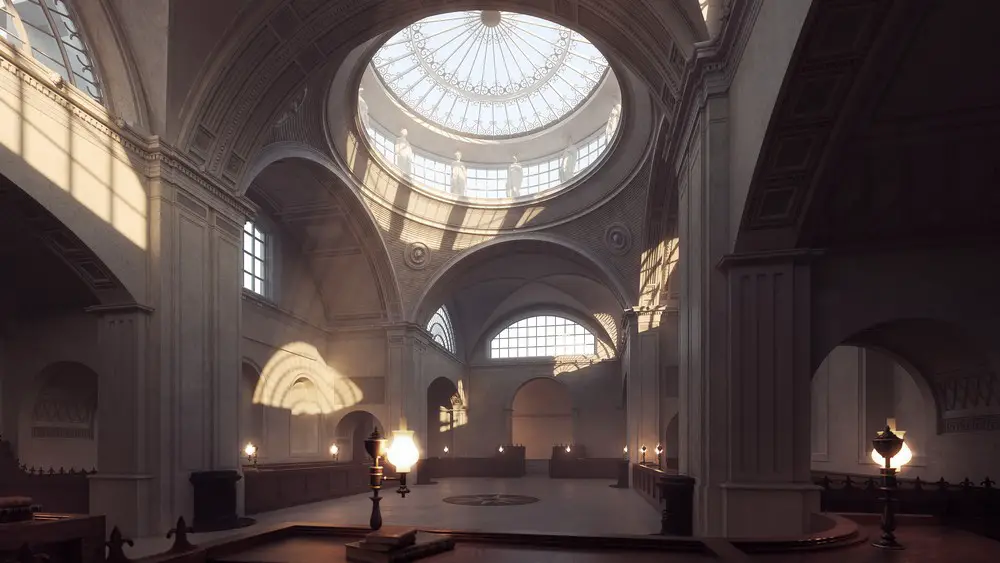Bank of England 325 years, 325 objects, London, John Soane Architecture
Bank of England 325th Anniversary Exhibition
Threadneedle Street Building Show, City of London, England, UK – design by architect John Soane
20 June 2019
Bank of England 325th Anniversary Exhibition News
325 years, 325 objects
Venue: Bank of England Museum
Dates: 22 July 2019 – 15 May 2020
@boemuseum
325TH ANNIVERSARY OF THE BANK OF ENGLAND
325 OBJECTS, MANY PREVIOUSLY UNSEEN, TELL THE STORIES OF THE BANK
- Story-filled exhibition covers art, design, architecture, politics, wartime, technology, fraud and forgery
- Objects drawn from the collections beneath Threadneedle Street include banknote designs, the earliest notes, Roman relics, 19th century forgeries, staff dexterity tests and a Cold War radiation calculator
- Exhibition features newly-commissioned floral banknote sculpture by artist Justine Smith
At the end of July, the Bank of England will be 325 years old. To celebrate the anniversary, the Bank of England Museum at Threadneedle Street will launch 325 years, 325 objects, a new exhibition telling the story of the Old Lady through items selected from the vast collections amassed since the Bank was founded in 1694. 325 years, 325 objects runs from 22 July 2019 to 15 May 2020 at the Bank of England Museum in Threadneedle Street in the heart of the City of London. Admission is free.
Banknote, 1762 First issue of £10 notes in 1759 due to shortage of metal currency during Seven Years War (1546-63). £10 note (worth nearly £2000 today):
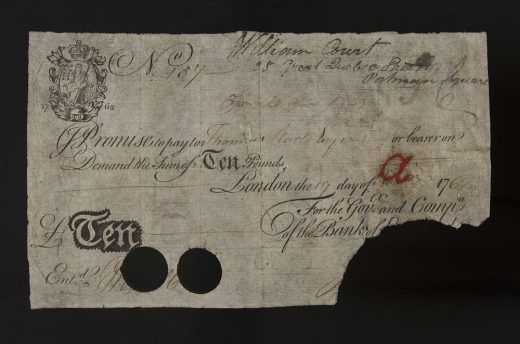
Spanning art, design, archaeology, architecture, ceremony, politics, wartime, the monarchy, security, fraud and forgery, crises, riots and technology, the exhibition is an absorbing presentation of world and social history from a genuinely unique perspective. Far from a predictable chronological trawl through history, it is a lively display of significant, surprising, beautiful and unusual items that have tales to tell. Full of stories, characters and moments in history, 325 years, 325 objects is drawn from the Museum’s own collections stored deep beneath Threadneedle Street.
The Bank of England Museum tells the story of the Bank, from its foundation in 1694 to its role today as the United Kingdom’s central bank. Within a full-size reconstruction of Sir John Soane’s 18th-century Stock Office, a large boat construction is full of interactive displays explaining how the Bank works, banknote design and security and how the Bank endeavours to keep the financial system on an even keel.
Botanical sculpture commissioned by the Bank for the exhibition. Created by artist Justine Smith, the sculpture takes the form of an arrangement of wild British flowers – bindweed, wild cherry, dog roses and hazel branches – all made from a combination of previously circulated (now unfit) £50 notes and uncirculated £50 test notes. The delicate, red floral arrangement will be presented in a silver water jug, dating from 1694, the year of the Bank’s foundation:
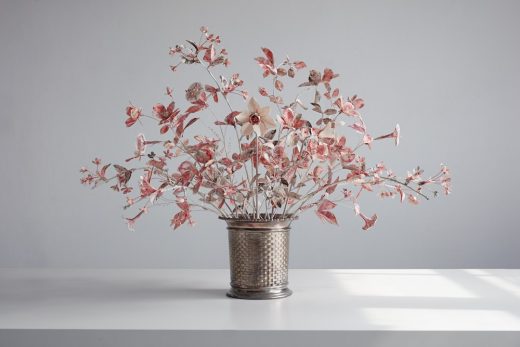
Among the highlights of the exhibition:
- The first banknotes, including an early note, dated 26th June 1702, issued to Elizabeth Head, an early investor in the Bank.
- Artwork sketches and test plates for banknote designs, including Jacobite design proofs from 1745 and a woodblock design for the first postal order from 1880.
- A still-wax-sealed packet containing a duplicate key to the door of the Bullion Office from 1784
- 19th and 20th century forged banknotes and printing plates
- Roman relics found during archaeological digs on the Threadneedle Street site.
- Handmade terracotta bricks taken from Sir John Soane’s Rotunda in his original Bank building and early 20th-century hand-painted wall tiles from the Bank’s parlours, featuring Britannia, Minerva, Pythagoras and more
- Manual dexterity tests given to Bank staff in the 1980s
- Cold War Calculator. A radiation fallout calculator, 1959/60, used to estimate the effects of a nuclear attack.
- Early views of the Bank building and its location in the City of London
- Depictions of a dozen monarchs across successive gold coins
Bank of England Gold Vault:
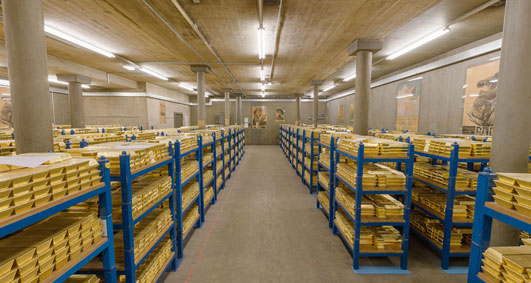
photo © Bank of England
One of the highlights of the exhibition is an exquisite botanical sculpture commissioned by the Bank for the exhibition. Created by artist Justine Smith, the sculpture takes the form of an arrangement of wild British flowers – bindweed, wild cherry, dog roses and hazel branches – all made from a combination of previously circulated (now unfit) £50 notes and uncirculated £50 test notes. The delicate, red floral arrangement will be presented in a silver water jug, dating from 1694, the year of the Bank’s foundation. Justine Smith said, “I am excited to see my work joining the collections of the Bank and lining up alongside 324 objects spanning its history. I am interested in the idea of wild flowers being tenacious and sturdy and finding their way to thrive wherever they can. And I’m using banknotes and I see them as a symbol of labour, strength and continuity – of putting down roots.”
Among the many little-known stories to be found in the exhibition is the terribly sad tale of the ‘Bank nun’, Sarah Whitehead, who, from 1812 to 1837, visited the Bank of England each day, dressed in mourning clothes. She was the sister of a former Bank Clerk who had been sentenced to death for forging an acceptance to a bill. Each day she came to the Bank, awaiting her brother, under the delusion that he was still employed there.
BoE Building courtyard:
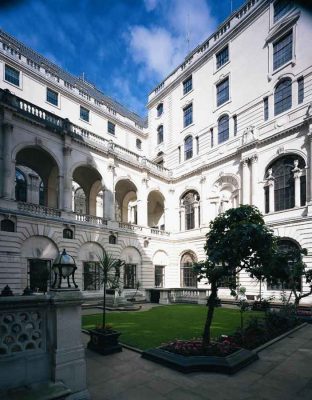
photo © Bank of England
Jennifer Adam, curator of the Bank of England Museum, said, “We are reaping the rewards of the fact that the Bank never threw anything away! The sheer variety of items at our disposal meant that the challenge posed by this exhibition was narrowing our selection down to just 325 objects. The display moves from the earliest banknotes to contemporary art made from polymer notes, from the first appearance of the Queen on our banknotes, to the very latest payment technology. We are especially pleased to be throwing light on some lesser-visited areas of the Bank’s history, including the work of the first female clerk, the life of staff at Threadneedle Street and Sir John Soane’s ‘lost’ Bank building.”
John Soane Medal., 1834. Bust of Soane on front; Tivoli corner on reverse. First issued in 1834 as ‘a Tribute of respect from RIBA’:
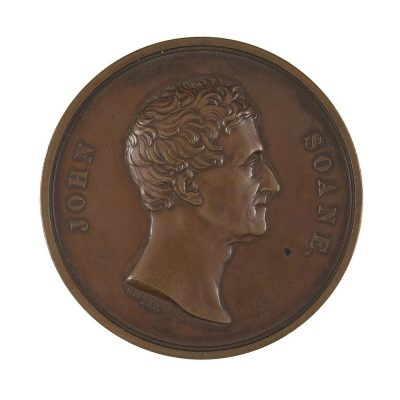
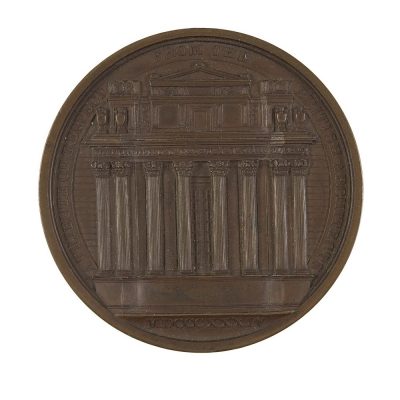
VISITOR INFORMATION
325 years 325 objects at the Bank of England Museum, Bartholomew Lane (off Threadneedle Street), London EC2R 8AH. Dates: 22 July 2019 – 15 May 2020. Admission: Free.
Opening hours: Monday-Friday: 10am-5pm (last entry 4:30pm). Closed Public and Bank Holidays and
weekends, except for special events taking place on those days.
More information: www.bankofengland.co.uk/museum 020 3461 5545 education@bankofengland.co.uk
Described tours, led by a Museum Guide, are available for visually impaired visitors. Booking is essential.
Groups: The Museum offers free talks and presentations to visiting groups of all ages. To arrange an event please email education@bankofengland.co.uk
New app Bank of England Garden Court:
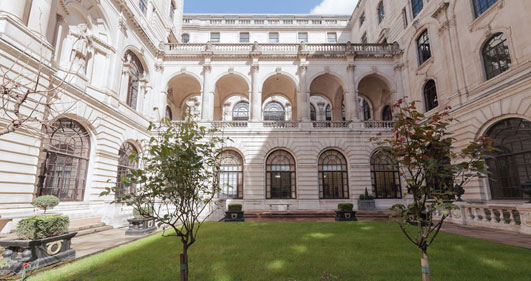
photo © Bank of England
Bank of England 325th Anniversary Exhibition images / information received 200619
Location: Bank of England, London, England, UK
Bank of England Building in London
Bank of England Building Digital Reconstruction
digitally reconstruct Soane’s Bank of England
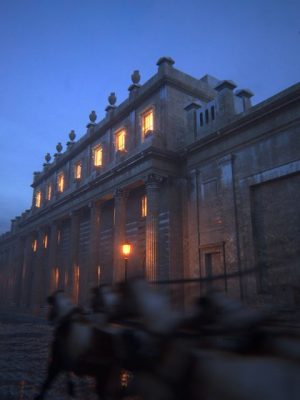
image : Andrii Rodych, 3DVisDesign, Ukraine
Bank of England Digital Reconstruction
Bank of England Virtual Tour App
Bank of England Building – aerial view from the south:
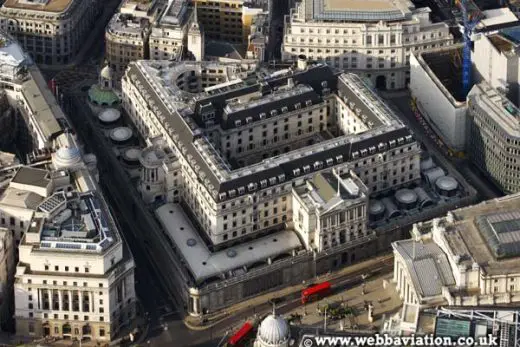
photo © webbaviation
Bank of England Building
London Architecture
London Architecture Design – chronological list
London Architecture Walking Tours
Rothschild Building, City of London Bank
Comments / photos for the Bank of England 325th Anniversary Exhibition page welcome

